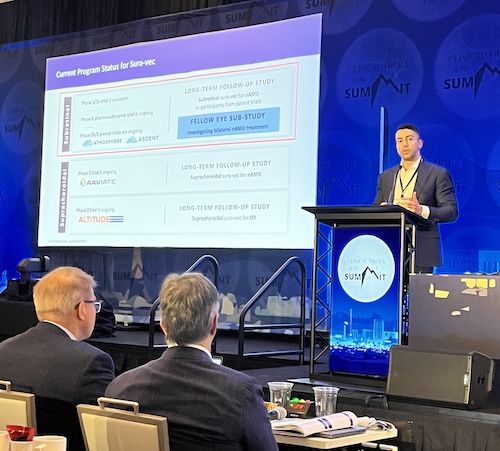This past weekend, Texas Retina’s Director of Clinical Research for Dallas Ashkan M. Abbey, MD, led two presentations at the annual Clinical Trials at the Summit (CTS) meeting in Las Vegas, which brings together retina specialists and industry partners from throughout the country to discuss advances in clinical research and showcase novel ideas.
Sustained-Release DURAVYU™: Update on Clinical Trials in Neovascular AMD
Dr. Abbey’s first presentation covered the results of recent clinical trials on the DURAVYU vorolanib intravitreal insert (EYP-1901) in patients with neovascular (wet) age-related macular degeneration (AMD). DURAVYU combines vorolanib, a selective tyrosine kinase inhibitor (TKI) of vascular endothelial growth factor (VEGF), with bioerodible Durasert E technology for sustained intravitreal drug delivery. It was designed to reach the target tissues within hours and provide controlled release over a period of at least 6 months.
He shared highlights of the DAVIO (Phase 1), DAVIO 2 (Phase 2), LUGANO (Phase 3), and LUCIA (Phase 3) studies. The DAVIO and DAVIO 2 trials are complete. The global LUGANO and LUCIA studies are ongoing with LUGANO fully enrolled and LUCIA still enrolling. Texas Retina is participating in both, which are assessing the efficacy and safety of DURAVYU compared to aflibercept, a standard treatment for wet AMD. Dr. Abbey serves as a Principal Investigator for the LUGANO trial and dosed the study’s very first patient last year. He also presented topline results from the DAVIO 2 clinical trial at the 2024 Retina World Congress.
Dr. Abbey’s recent CTS presentation highlighted the following advantages of DURAVYU based on the latest available clinical trials data:
- Immediate impact as the drug reaches therapeutic levels within hours
- Continuous daily dosing with zero-order kinetics and no fluctuations
- Sustained VEGF receptor inhibition through ≥6 months
- Substantially reduced treatment burden
“DURAVYU has the largest clinical trial program to date for an intravitreal sustained-release therapy for neovascular AMD, so it is exciting to see such positive results,” comments Dr. Abbey. “While the Phase III trials are still ongoing, so far it is achieving desired safety and effectiveness while helping patients go longer between treatments.”
Subretinal Delivery of Investigational ABBV-RGX-314 as a Gene Therapy for Neovascular AMD
Dr. Abbey’s second CTS presentation reviewed the one-year results of a fellow eye bilateral dosing study
of subretinal ABBV-RGX-314 (sura-vec) in patients with wet AMD. Designed as a one-time gene therapy, ABBV-RGX-314 (sura-vec) uses an adeno-associated virus (AAV) vector to deliver a gene that encodes an antibody fragment designed to neutralize VEGF.
“It aims to reduce the treatment burden for patients by providing a long lasting-solution that continuously suppresses VEGF activity,” explains Dr. Abbey. “Neovascular AMD is frequently a bilateral disease and the ability to treat both eyes with gene therapy is important.”
The Phase IIb/III ASCENT and ATMOSPHERE clinical trials are evaluating the efficacy and safety of subretinal delivery of ABBV-RGX-314 (sura-vec) in patients with wet AMD versus standard of care. ASCENT is using aflibercept as the comparator, while ATMOSPHERE is using ranibizumab. Dr. Abbey serves as a Principal Investigator for both studies, and Texas Retina’s Director of Clinical Research for Fort Worth Patrick D. Williams, MD, serves as a Principal Investigator for ASCENT.
During his CTS presentation, Dr. Abbey shared the findings of subretinal ABBV-RGX-314 for second eyes through year 1 for open-label participants:
- Well-tolerated
- Sustained vision and anatomy
- Meaningful reduction in anti-VEGF injection burden
- 60% injection-free
- 80% required 0 or 1 supplemental injection
- 93% reduction in anti-VEGF treatment burden
About Ashkan Abbey, MD
In addition to serving as Director of Clinical Research for Dallas, Dr. Abbey cares for patients in Texas Retina’s Dallas Main and Rockwall offices. You can learn more about him here.
Click here to learn more about all of Texas Retina’s currently enrolling clinical trials.


